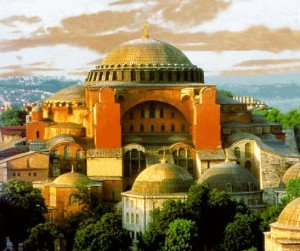 Chrysostom no doubt officiated in each of the several large churches with which the city of Constantinople had been adorned since 330. In addition to the original Hagia Sophia (Holy Wisdom), the Great Church which served as the Cathedral and begun by Constantine and completed in 360 by Constantius, there existed the High Church, Hagia Irene (Holy Peace), close by, and the Church of the Apostles, the former enlarged and beautified by Constantine, the latter built by him. These churches were all basilicas. Although none have survived as active places of Christian worship, they are museums and we are certain of their features and their influence on the Liturgy. Worshippers first entered through an imposing portico, whose doorway might be hung with rich curtains. They found themselves in an atrium, or forecourt, surrounded on three sides by a columned arcade. In the middle was a fountain where the faithful could wash their hands on their way into church, as much in preparation for prayer as for receiving the sacrament. The atrium was also where the poor gathered in the hope of receiving alms from the churchgoers.
Chrysostom no doubt officiated in each of the several large churches with which the city of Constantinople had been adorned since 330. In addition to the original Hagia Sophia (Holy Wisdom), the Great Church which served as the Cathedral and begun by Constantine and completed in 360 by Constantius, there existed the High Church, Hagia Irene (Holy Peace), close by, and the Church of the Apostles, the former enlarged and beautified by Constantine, the latter built by him. These churches were all basilicas. Although none have survived as active places of Christian worship, they are museums and we are certain of their features and their influence on the Liturgy. Worshippers first entered through an imposing portico, whose doorway might be hung with rich curtains. They found themselves in an atrium, or forecourt, surrounded on three sides by a columned arcade. In the middle was a fountain where the faithful could wash their hands on their way into church, as much in preparation for prayer as for receiving the sacrament. The atrium was also where the poor gathered in the hope of receiving alms from the churchgoers.
The church itself was entered by way of the narthex, or porch (now called the vestibule), on the fourth side of the atrium. Several doors led into the narthex, where people could gather before the service began. Whether or not they entered the church before the bishop arrived is not clear (there was always a procession of the clergy, with the bishop, into the church. In the renewed Latin Liturgy, we see this reinstated and we still see this when a bishop visits the church).
Certainly in the first half of the seventh century the congregation seems to have gathered outside the church, and to have entered it only after the bishop had made his ceremonial entrance. The larger churches all seem to have had doors at the east end, on either side of the apse, as well as at the west end, and often in the north and south sides too. The central doors leading from the narthex into the nave were known as the royal doors, and it was through them that the Emperor entered with the Patriarch into the church on those occasions when he took part formally in the Liturgy. The name royal doors was only later given to the doors that eventually developed on the iconastasis (originally the iconastasis had no doors). Al-Masih-Qam!
